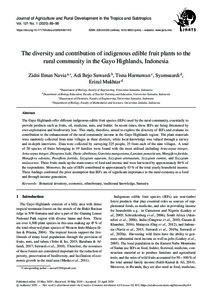The diversity and contribution of indigenous edible fruit plants to the rural community in the Gayo Highlands, Indonesia
| dc.date.accessioned | 2020-05-19T12:23:54Z | |
| dc.date.available | 2020-05-19T12:23:54Z | |
| dc.date.issued | 2020-05-15 | |
| dc.identifier | doi:10.17170/kobra-202004061145 | |
| dc.identifier.uri | http://hdl.handle.net/123456789/11561 | |
| dc.description | Gedruckte Ausgabe im Verlag kassel university press erschienen. | ger |
| dc.language.iso | eng | eng |
| dc.rights | Namensnennung 4.0 International | * |
| dc.rights.uri | http://creativecommons.org/licenses/by/4.0/ | * |
| dc.subject | botanical inventory | eng |
| dc.subject | economic | eng |
| dc.subject | ethnobotany | eng |
| dc.subject | traditional knowledge | eng |
| dc.subject | Sumatra | eng |
| dc.subject.ddc | 630 | |
| dc.title | The diversity and contribution of indigenous edible fruit plants to the rural community in the Gayo Highlands, Indonesia | eng |
| dc.type | Aufsatz | |
| dcterms.abstract | The Gayo Highlands offer different indigenous edible fruit species (IEFs) used by the rural community, essentially to provide products such as fruits, oil, medicine, nuts, and fodder. In recent times, these IEFs are being threatened by over-exploitation and biodiversity loss. This study, therefore, aimed to explore the diversity of IEFs and evaluate its contribution to the enhancement of the rural community income in the Gayo Highlands region. The plant materials were randomly collected from nine villages in three districts, while local knowledge was valued through a survey and in-depth interviews. Data were collected by surveying 225 people, 25 from each of the nine study areas,. A total of 38 species of fruits belonging to 19 families were found with the most utilised including Artocarpus integer, Baccaurea motleyana, Diospyros kaki, Durio zibethinus, Garcinia mangostana, Lansium parasiticum, Mangifera foetida, Mangifera odorata, Passiflora foetida, Syzygium aqueum, Syzygium attenuatum, Syzygium cumini, and Syzygium malaccense. These fruits made up the main source of food and income and were harvested by approximately 86 % of the respondents. Moreover, the sale of IEFs contributed to approximately 43 % of the total yearly household income. These findings confirmed the prior assumption that IEFs are of significant importance to the rural economy as a food and through income generation. | eng |
| dcterms.accessRights | open access | |
| dcterms.creator | Navia, Zidni Ilman | |
| dcterms.creator | Suwardi, Adi Bejo | |
| dcterms.creator | Harmawan, Tisna | |
| dcterms.creator | Syamsuardi | |
| dcterms.creator | Mukhtar, Erizal | |
| dc.subject.swd | Essbare Frucht | ger |
| dc.subject.swd | Vielfalt | ger |
| dc.subject.swd | Lebensunterhalt | ger |
| dc.subject.swd | Ländlicher Raum | ger |
| dc.subject.swd | Sumatra | ger |
| dc.type.version | publishedVersion | |
| dcterms.source.identifier | EISSN 2363-6033 | |
| dcterms.source.issue | No. 1 | |
| dcterms.source.journal | Journal of Agriculture and Rural Development in the Tropics and Subtropics (JARTS) | eng |
| dcterms.source.pageinfo | 89-98 | |
| dcterms.source.volume | Vol. 121 | |
| kup.iskup | false |
Dateien zu dieser Ressource
Das Dokument erscheint in:
-
Vol 121, No 1 (2020) [13]


